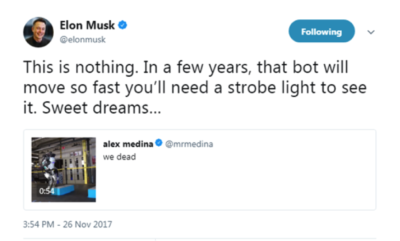This post Elon Musk’s Biggest Fear, Realized appeared first on Daily Reckoning.
Have you heard about Atlas, the most advanced humanoid robot on the planet?
I’ll bet the farm you’ve never seen anything like it before.
Last week, former Alphabet subsidiary Boston Dynamics released new video demonstrating their Atlas robot’s new capabilities.
It could revolutionize what we think the “factory robot” can do. Atlas can be knocked off its path and then correct itself. It can do backflips, too.
It has dexterity no robot has ever had. What does that mean for you and me?
How You Get a Robot to Do Backflips
The trend to “humanize” robotics has captured the minds of scientists for decades.
But until now the technology has failed to give these robots the ability to move and react quickly to changing conditions around them.
How does a robot know to circumvent spills or other factory hazards?
What happens when it gets bumped into while running supplies from one side of a warehouse to the other?
How does it avoid getting bumped in the first place?
To be able to “think on one’s feet” has traditionally been the edge every human worker has held over its robot counterpart.
But the gap is closing quickly.
The dexterity Atlas shows as it navigates hazards and performs tasks completely reinvents how we need to consider automated workforces.
But the video has also raised the ire of some. Even Elon Musk, who recently tweeted:
It’s important to take Musk’s tweet with a grain of salt. For one, Musk’s Space X and Tesla companies are leaders in AI and robotics.
But Musk willingly plays devil’s advocate. It must be acknowledged that even the best innovations and advances are not without their issues or unintended consequences.
But technology, even as advanced as Atlas, is not something we should fear. We should embrace the change. Or at the very least get used to it.
Because like it or not, the robotics trend will continue to imprint itself across major industries more and more in the coming years.
Which leads me to six important “laws” of technology that help explain what’s happening in robotics today.
In 1986, technology historian Melvin Kranzberg established six crucial rules to follow when evaluating technology’s impact on our world.
Today, I’d like to share these rules with you and quell some of the alarmism.
The Six Laws of Tech You Need to Know
1. “Technology is neither good nor bad; nor is it neutral.”
Kranzberg’s first law is perhaps the most important one to remember. There is no inherent good or evil to any technology. The historical, political and economic context weighs far more heavily on whether a technology is good or bad.
This includes robots like Atlas.
2. “Invention is the mother of necessity.”
Tech innovations almost always require new advances before becoming truly useful. This powers the development of new ideas and eventually leads to new industry growth.
Take electric cars, for example. This trend included the development of new batteries, new lightweight materials, new infrastructure and so on.
3. “Technology comes in packages, big and small.”
Take your smartphone. Manufacturers created the …read more
Source:: Daily Reckoning feed
The post Elon Musk’s Biggest Fear, Realized appeared first on Junior Mining Analyst.

